Worldwide, more than 61% of women experience premenstrual mood swings and anxiety every menstrual cycle. Those two particular symptoms are very common that Virginia researchers believe premenstrual syndrome, or PMS, should be a key public health issue globally.
“Our study demonstrates that premenstrual mood symptoms are incredibly common worldwide,” said Dr. Jennifer L. Payne, the study’s senior author and director of the Reproductive Psychiatry Research Program at the University of Virginia School of Medicine.
“More importantly, a majority of women reported that their premenstrual symptoms interfered with their everyday life at least some of the time,” she said.
The study was done by the UVA School of Medicine, Johns Hopkins University and Flo Health. It involved surveying women between the ages of 18 to 55 from 140 countries. The data was collected using the Flo app, which women used to track their menstrual cycle or track symptoms during and after pregnancy.
The results showed that the mood and anxiety symptoms varied from country to country, with a low of 35.1% in Congo to a high of 68.6% in Egypt.
“Understanding whether differences in biology or culture underlie the country level rates will be an important future research direction,” Payne said in a news release.
With PMS, the most common symptoms, according to the findings, were food cravings. It was reported by 85% of the women surveyed. Mood swings and anxiety were experienced by 64% of women and that was followed by 57% reporting fatigue.
The mood swings and anxiety also take a toll on a woman’s daily life, with 29% reporting that their premenstrual symptoms interfered with their everyday life during every menstrual cycle, while an additional 35% claim their premenstrual symptoms interfered with their everyday life sometimes.
The information also found that older participants in the survey reported absent-mindedness, low libido, sleep changes, gastrointestinal symptoms, weight gain, headaches, sweating or hot flashes, fatigue, hair changes, rashes and swelling more frequently.
According to Payne, the increase in physical symptoms among older survey takers may be a result of many of these symptoms being associated with perimenopause, which is a transition period to menopause marked by irregular menstrual cycles.
Payne is hopeful the study, which was published in Archives of Women’s Health, may result in women worldwide getting better care by doctors being more aware of how often women experience these symptoms.
“Increasing awareness of how common these symptoms are, and that if they impact functioning, that there are treatments available, and will help women improve their quality of life,” Payne said.








